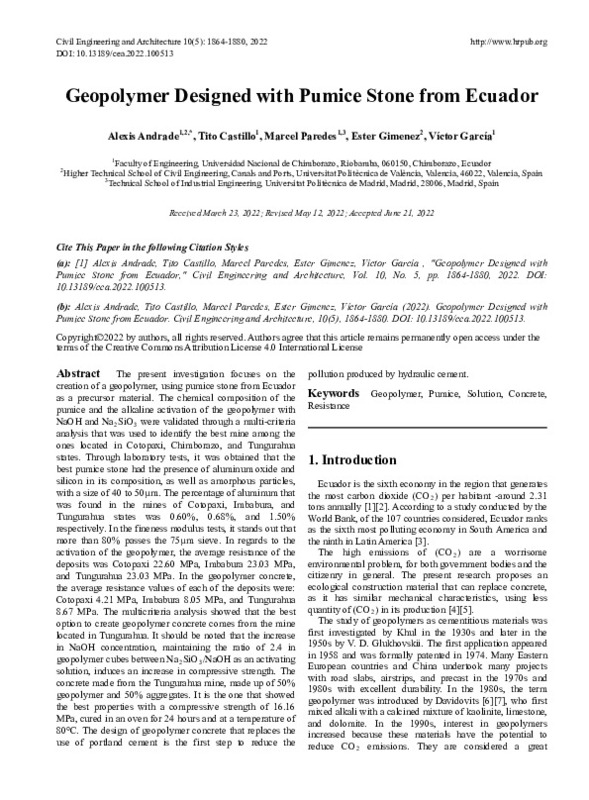JavaScript is disabled for your browser. Some features of this site may not work without it.
Buscar en RiuNet
Listar
Mi cuenta
Estadísticas
Ayuda RiuNet
Admin. UPV
Geopolymer Designed with Pumice Stone from Ecuador
Mostrar el registro sencillo del ítem
Ficheros en el ítem
| dc.contributor.author | Andrade, Alexis
|
es_ES |
| dc.contributor.author | Castillo, Tito
|
es_ES |
| dc.contributor.author | Paredes, Marcel
|
es_ES |
| dc.contributor.author | Gimenez-Carbo, Ester
|
es_ES |
| dc.contributor.author | García, Victor
|
es_ES |
| dc.date.accessioned | 2023-02-13T19:00:41Z | |
| dc.date.available | 2023-02-13T19:00:41Z | |
| dc.date.issued | 2022 | es_ES |
| dc.identifier.issn | 2332-1091 | es_ES |
| dc.identifier.uri | http://hdl.handle.net/10251/191804 | |
| dc.description.abstract | [EN] The present investigation focuses on the creation of a geopolymer, using pumice stone from Ecuador as a precursor material. The chemical composition of the pumice and the alkaline activation of the geopolymer with NaOH and Na2SiO3 were validated through a multi-criteria analysis that was used to identify the best mine among the ones located in Cotopaxi, Chimborazo, and Tungurahua states. Through laboratory tests, it was obtained that the best pumice stone had the presence of aluminum oxide and silicon in its composition, as well as amorphous particles, with a size of 40 to 50µm. The percentage of aluminum that was found in the mines of Cotopaxi, Imbabura, and Tungurahua states was 0.60%, 0.68%, and 1.50% respectively. In the fineness modulus tests, it stands out that more than 80% passes the 75µm sieve. In regards to the activation of the geopolymer, the average resistance of the deposits was Cotopaxi 22.60 MPa, Imbabura 23.03 MPa, and Tungurahua 23.03 MPa. In the geopolymer concrete, the average resistance values of each of the deposits were: Cotopaxi 4.21 MPa, Imbabura 8.05 MPa, and Tungurahua 8.67 MPa. The multicriteria analysis showed that the best option to create geopolymer concrete comes from the mine located in Tungurahua. It should be noted that the increase in NaOH concentration, maintaining the ratio of 2.4 in geopolymer cubes between Na2SiO3/NaOH as an activating solution, induces an increase in compressive strength. The concrete made from the Tungurahua mine, made up of 50% geopolymer and 50% aggregates. It is the one that showed the best properties with a compressive strength of 16.16 MPa, cured in an oven for 24 hours and at a temperature of 80°C. The design of geopolymer concrete that replaces the use of portland cement is the first step to reduce the pollution produced by hydraulic cement. | es_ES |
| dc.language | Inglés | es_ES |
| dc.publisher | Horizon Research Publishing | es_ES |
| dc.relation.ispartof | Civil Engineering and Architecture | es_ES |
| dc.rights | Reconocimiento (by) | es_ES |
| dc.subject | Geopolymer | es_ES |
| dc.subject | Pumice | es_ES |
| dc.subject | Solution | es_ES |
| dc.subject | Concrete | es_ES |
| dc.subject | Resistance | es_ES |
| dc.subject.classification | INGENIERIA DE LA CONSTRUCCION | es_ES |
| dc.title | Geopolymer Designed with Pumice Stone from Ecuador | es_ES |
| dc.type | Artículo | es_ES |
| dc.identifier.doi | 10.13189/cea.2022.100513 | es_ES |
| dc.rights.accessRights | Abierto | es_ES |
| dc.contributor.affiliation | Universitat Politècnica de València. Escuela Técnica Superior de Ingenieros de Caminos, Canales y Puertos - Escola Tècnica Superior d'Enginyers de Camins, Canals i Ports | es_ES |
| dc.description.bibliographicCitation | Andrade, A.; Castillo, T.; Paredes, M.; Gimenez-Carbo, E.; García, V. (2022). Geopolymer Designed with Pumice Stone from Ecuador. Civil Engineering and Architecture. 10(5):1864-1880. https://doi.org/10.13189/cea.2022.100513 | es_ES |
| dc.description.accrualMethod | S | es_ES |
| dc.relation.publisherversion | https://doi.org/10.13189/cea.2022.100513 | es_ES |
| dc.description.upvformatpinicio | 1864 | es_ES |
| dc.description.upvformatpfin | 1880 | es_ES |
| dc.type.version | info:eu-repo/semantics/publishedVersion | es_ES |
| dc.description.volume | 10 | es_ES |
| dc.description.issue | 5 | es_ES |
| dc.relation.pasarela | S\469839 | es_ES |
| dc.subject.ods | 09.- Desarrollar infraestructuras resilientes, promover la industrialización inclusiva y sostenible, y fomentar la innovación | es_ES |
| dc.subject.ods | 12.- Garantizar las pautas de consumo y de producción sostenibles | es_ES |
| dc.subject.ods | 13.- Tomar medidas urgentes para combatir el cambio climático y sus efectos | es_ES |








